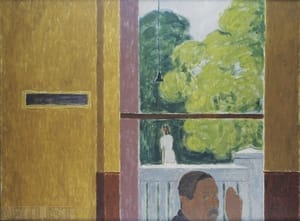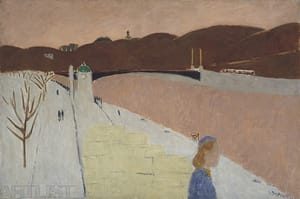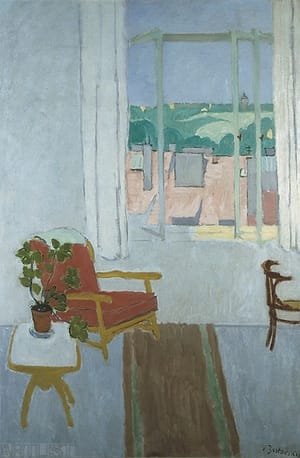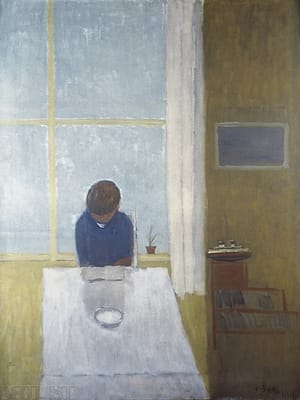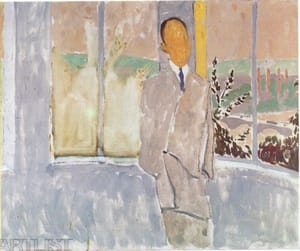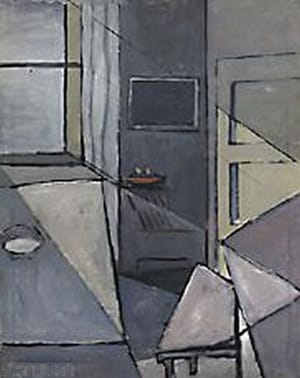- First Name
- Václav
- Surname
- Bartovský
- Born
- 1903
- Birth place
- Prague
- Died
- 1961
- Keywords
- CSU Library
- ↳ Find in the catalogue
About artist
Václav Bartovský was an autodidact. He was born in Prague, where he lived all of his life. He came from a working class family whose poverty prevented him from studying what he wanted to, i.e. painting. Nevertheless, he joined the art scene in 1927 with his first solo exhibition. The twenties and thirties were a period of searching. It was difficult to alight on a particular programme at this time, since the important avant-garde works had already been created. After a short flirtation with realism taking commonplace urban scenery as its subject matter, Bartovský embarked on a clarification of the principles of certain directions in modern painting. To begin with he was taken with cubist spatial composition, and was also influenced by surrealism. Matisse, with his coloured spatial composition, played an important role for Bartovský. These lessons were hugely important for the artist as autodidact, leading him to mastery of the laws of visual composition. During the thirties he refined his characteristic style of painting, in which the artist’s sensual approach to reality is sensitively combined with the fixed rules of visual composition.
In terms of their form and content, the paintings from the forties form an important creative whole in which Bartovský took his work to a new level of maturity. He concentrated on civic topics: interiors in which people feature more and more, the scenery of Prague streets, coffee bars, etc. Formally speaking Bartovský reduces his field of view, recording only those signs of reality which for him were the most important carriers of significance. The pictures take one by surprise with their unusually clean painterly expressiveness, characterised by a minimalist draftsmanship, a limited range of colour, and a pellucid layer of thinly applied paint. The coloured surfaces do not create a compact whole (such as in the case of Matisse, for example), but are punctuated by the luminous vibration of the atmosphere. Bartovský’s paintings from the forties are a painter’s testimony regarding the deepest feelings of a person living within a civilised environment. They are contemplative and free of any dramatic expression. In the fifties Bartovský also painted many portraits (of Adriena Šimotová and Jiří John amongst others). At the end of the fifties he returned to subjects taken from urban life. In the paintings from that time he arrives at the maximally reduced expression of the most basic attributes of reality. The paintings are less contemplative. Instead, the artist attempts to get directly to the centre of the teeming street life of humans. Time flows more quickly and space is more compact in these paintings.
Like many autodidacts before and since, Václav Bartovský was an extremely cultured person. As well as fine art he was involved in literary activities. He published articles on important personalities in the local and global art world. Like his art, his literary output is also characterised by an unusually pure and cultivated style. For this reason he attracted young colleagues, for whom he was not only an artistic but intellectual support. Likewise, Bartovský often found greater understanding amongst the young than that displayed by generations closer to his own. This fact was mainly caused by his unremitting search for the most appropriate statement regarding a constantly evolving period. In the second half of the fifties Bartovský formed a close friendship with artists of the now legendary group UB 12. The relationships were so strong that members of the group included Bartovský’s work in their first joint exhibition in 1962 at the Československý Spisovatel [Czech Writer] publishing house on Národní třída in Prague.
Václav Bartovský was an artist who pursued his own path all of his life. He was unobtrusive, modest, and had no desire to draw attention to himself. His paintings reflect his aspect of the man: they are quiet and restrained, they don’t want to shock by means of flamboyant gestures and dramatic exaggeration or to resort to special effects. Few critics paid much attention to Bartovský’s work during his lifetime. Despite this the work of Václav Bartovský has found a place for itself in the development of Czech art.
- Author of the annotation
- Ivona Raimanová
CV
Studies: autodidact
- Member of art groups included in ARTLIST.
- Member of art groups not included in ARTLIST.
- Umělecká beseda
Exhibitions
- Solo exhibitions
-
1985 Galerie výtvarných umění, Litoměřice a Galerie Benedikta Rejta, Louny (Luna exhibition hall)
1983 Ústřední kulturní dům železničářů, Praha
1983 Galerie umění, Karlovy Vary
1964 Galerie výtvarného umění, Ostrava
1963 Československý spisovatel, Praha
1962 Galerie Jaroslava Krále, Brno
1948 Topičův salon, Praha
1927 Krasoumná jednota, Dům umělců, Praha
- Group exhibitions not included in ARTLIST.
-
2005 Výstava české krajinomalby, Oblastní galérie, Liberec
1980 Česká figurativní malba 40. let, Roudnice nad Labem
1979 Česká portrétní malba 20. století, Dům pánů z Kunštátu, Brno
1968 50 let české kresby, galérie Letná, Praha
1963 Sto let Umělecké besedy, Jízdárna Pražského hradu, Praha
1962 UB 12, Československý spisovatel, Praha
1948 Členská výstava Umělecké besedy, Praha
1943 Členská výstava Umělecké besedy, Praha
1942 Členská výstava Umělecké besedy, Praha
1939 Důvěřujte umění, Mánes Praha
1938 III. zlínský salón, Zlín
1937 II. zlínský salón, Zlín
1936 I. zlínský salón, Zlín
1936 Členská výstava SVU Mánes, Praha
1932 XLVII. členská výstava Sdružení výtvarníků v Praze
- Collections
- National Gallery, Czech Museum of Fine Arts Prague, City Gallery Prague, Benedikt Rejt Gallery in Louny, Art Museum Karlovy Vary, Distruct Gallery in Liberec, Gallery of Modern Art in Roudnice, South-Bohemian Gallery of Mikoláš Aleš in Hluboká n.V., Gallery of Fine Arts in Ostrava, private collections
Monography
- Monography
Raimanová I., Václav Bartovský, katalog výstavy, Galerie výtvarného umění v Litoměřicích, 1985
Raimanová I., Václav Bartovský, katalog výstavy, Galerie umění Karlovy Vary, 1983
Padrta J., Václav Bartovský, katalog výstavy, Galerie Československého spisovatele, Praha 1963
Padrta J., Václav Bartovský, NČSVU, Praha 1960
Kohoutek J., Václav Bartovský, katalog výstavy, Ústřední kulturní dům železničářů, Praha 1985
Chalupecký J., Václav Bartovský, katalog výstavy, Topičův salón, Praha 1948
- Articles
Brožková L., Poznámky k portrétu v českém malířství 1920-1960, Výtvarné umění XIII, 1963, s. 55
Halířová-Muchová M., Portrétní tvorba, Odeon, Praha 1981, s.36-37
Hlaváček L., Dílo Václava Bartovského, Mladá fronta XIX, 1963, č. 302, s. 4
Hockeová J. Česká portrétní malba XX. století, Dům umění města Brna, 1979
Chalupecký J., Aktuálnost impresionismu, Listy III, 1948, č. 2, s. 133
Kotalík J., Obrazy Václava Bartovského, Svobodné noviny IV, 1948, č. 28, s. 5
Laudová V., Obraz malířství v současném malířství, Odeon, Praha 1978, s. 34-35
Padrta J., Rozhovor s Václavem Bartovskýmm Výtvarné umění VIII, 1958, s. 344-349
Padrta J., Václav Bartovský, Výtvarné umění XI, 1961, s. 234-235
Sovák P., Václav Bartovský, Výtvarná práce VI, 1958, č. 8, s. 8
Šetlík J., Tvůrčí skupiny UB 12, katalog výstavy, Galerie Československého spisovatele, Praha 1962
Šetlík J., Malíř Václav Bartovský zemřel, Literární noviny X, 1961, č. 32, s. 4
vh, Nový harmonisátor malby, Mladá fronta IV, 1948, č. 16, s. 5
Vladislav J., Ateliér světa a srdce, in: Pražské ateliéry, NČSVU, Praha 1961, s. 10
Volek, V., Dvacetileté mezidobí Václava Bartovského, Lidová kultura IV, 1948, č. 3, s. 7
Zhoř I., Václav Bartovský, Host do domu IX, 1962, č. 10, s 466
